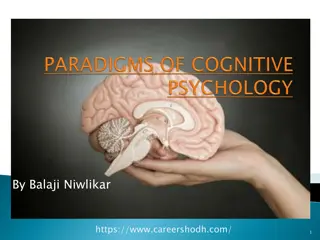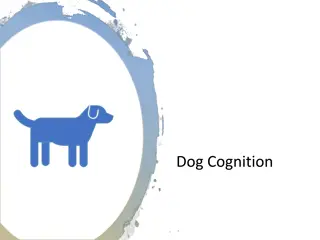Unveiling the Intelligence of Dogs: A Closer Look at Dog Cognition
Dogs possess remarkable cognitive abilities that surpass common beliefs. With a strong capacity for social and nonsocial learning, discrimination, contingency reversal, object permanence, categorization, and inferential learning, dogs exhibit behaviors indicative of advanced cognitive-emotional capabilities. Studies on dog cognition explore the evolutionary origins and cognitive processes that underlie their interactions with humans and fellow canines.
Download Presentation

Please find below an Image/Link to download the presentation.
The content on the website is provided AS IS for your information and personal use only. It may not be sold, licensed, or shared on other websites without obtaining consent from the author.If you encounter any issues during the download, it is possible that the publisher has removed the file from their server.
You are allowed to download the files provided on this website for personal or commercial use, subject to the condition that they are used lawfully. All files are the property of their respective owners.
The content on the website is provided AS IS for your information and personal use only. It may not be sold, licensed, or shared on other websites without obtaining consent from the author.
E N D
Presentation Transcript
Dog Cognition They are smarter than we think!
70% of U.S. households have at least one pet 53% have at least 1 dog. 55+ million dogs in U.S. alone Estimated $45 billion/year industry Some statistics on dogs as pets Why dogs? Dog (and cat) behavior appears to be attuned to humans As companion animals, show loyalty , compassion , and other cognitive-emotional behaviors
Unlike other domestic animals, wild conspecifics are readily available for comparison Data are available showing domestication of a wild canine species (Fox) which demonstrates evolution of many dog-like traits. Why study dog cognition? Appear to have social cognitive abilities that are more advanced than most non-human primates. Question is why? Yep, those two competing theories to explain evolution of cognition in dogs: Domestication hypothesis (Hare & Tomasello, 2005) Two-Stage hypothesis (Wynne)
Nonsocial learning Demonstrations of learning and problem solving that requires no social cues Dogs can do a lot of high level behavior! Social learning Demonstrations of learning and problem solving that require social cues from other dogs or humans
Strong discrimination learning Most often use Matching to Sample (MTS) or Delayed Matching to Sample (DMTS) Matching to Sample (MTS): Shown an item Given an array of objects Must match the item to the identical one in the array. Delayed Matching to Sample: There is a delay between the item and the array Must remember what you saw to pick its match. Nonsocial Learning Visual cues Color of objects: blue vs. orange, black vs. white E.g., Milgram, et al, 1994; Araujo, et al, 2014 Spatial cues: body position and landmarks Better at body position (L, R) Milgram, et al 1999; Ashton and DeLillo, 211 Auditory cues: Go/no go: Brown and Slotysik (1999) Different sounds Human vocal signals (McConnel, 1999) Olfactory cues, particularly nonsocial odor cues
Contingency reversal learning: Can learn A B and then B A (Ashton& DeLillo, 2011) Object permanence: Nonsocial Learning Can find hidden object when observe object being hidden Some data ((Gagnon & Dore, 1992, 1994) suggests dogs can find the object when they DO NOT see the object being hidden Object learning (Framl & Frank, 1985) Categorizing and inferential learning: (Range, et al, 2008)
Dogs show Object manipulation (Topal, et al, 1997) Dogs can do Means-end tasks (Osthaus et al, 2005) Quantitative tasks Nonsocial Learning More vs. less Some counting Search order Spatial navigation: (Cattet & Etienne, 2004) and solving detour problems (Pongracz, et al, 2001)
Dogs can count? Show Numerical competence and ability to discriminate more and less Dogs about as good at numerical competence as the great apes! West and Young (2002) from Pepperberg (1994) Nonsocial counting: Dogs shown three problems 1+1 = 2; 1+1=1; 1+1=3 All in dog biscuits; shown problem then solution Dogs gazed longer when the expected solution was wrong
Tinkelpaugh (1928) task Show food item Cover it up with a cup Slide to animal Animal lifts up cup- but tricked: another lesser preferred food is there Look to see if animal is surprised/upset Expectancy violations Dogs show strong expectancy violation So do chimps, corvids
Rico: Kaminski, Call & Fisher, 2004 Learned 200 nouns Language learning? Chaser: http://www.youtube.com/watch?v=_6479QAJuz8 Pilley and Reid, 2011 Learned 600 names of objects Also can deduce new objects; show inference May be partially do to novelty effects http://www.youtube.com/watch?v=_6479QAJuz8 http://www.youtube.com/watch?v=_6479QAJuz8
John Pilley passed away in June, 2018 Chaser passed away a year later in July, 2019 at age 15.
Social Learning: Dogs Can: Selectively avoid forbidden food, but grab it when the owner is not looking Beg from an individual that can see them, rather than their owner who cannot. Learn via Social learning and Imitation Watch human for cues to obtain food/toy Can be taught to imitate: do it Follow a human point: sensitive to Arm point Head turning Nodding Bowing Glancing in direction of target Miklosi & sporoni, 2006; Agnette et al, 2000; Udell, et al, 2008
Sensitivity to human social stimuli Reliably alter behavior in presence of such stimuli to obtain reinforcement These behaviors emerge after instruction or mediation of human companion Sensitivity to human social cues Theory of Mind and Dogs: Heyes (1998): an animal with a theory of mind believes that mental states play a causal role in generating behavior and infers the presence of mental states in others by observing their appearance and behavior under various circumstances . Several sets of data point to such an ability in dogs
Can do perspective taking Change reaction to forbidden food (Call, et a, 2003; Tomasello, 2008) Change where drop ball depending on position of human Begging responses change depending on actions of human Social learning Attempt to communicate with humans: Move objects closer Indicate location of items Ask for help with problem Occurs as early as 8 weeks Service dogs are better! Miklosi, et al, 2003; Viranyi, et al, 2006; Topal, et al, 2006
Greater degree of socialization = better skills Dogs can count? Numerical competence and ability to discriminate more and less Follow human gestures What does other research say? Can be fooled by humans pointing wrong direction Dogs about as good at numerical competence as the great apes! Dogs may perform actions that are counterproductive for themselves if humans ask for that action
Attend to owners Please owners by obeying commands, doing what owners desire What has years of socialization selected dogs to do? Why choose owner s preference? Dogs are selected to both Attend to humans Choose most food
Study by Prato-Previde, Marshall- Pescini and Valsecchi (Italians!). Interested in how dogs owners may influence how dogs choose between bigger and smaller choice Is your choice my Choice? Food choice is particularly strong Most dogs food driven Choose bigger (evolutionary drive, too!) But, also want to please their owners
Method 54 dog-owner dyads Mostly pure breeds Some mixed breeds Three different tasks: Bigger smaller choice 1:1 choice with human pointing to a particular choice Bigger smaller choice with human pointing to smaller Also gave the CBARQ assessment Several subscales on aggression, excitation, separation anxiety, general fears Did not feed dogs for several hours before study
Results Dependent variable: What choice the dogs made Free choice condition 74% chose large quantity more often 18% chose smaller 8% showed no preference
1:1 condition: 82% chose owners choice 6% chose opposite plate 12% showed no preference Results Bigger/Smaller owners preference 32% chose larger 32% chose owner s choice 36% chose both equally often
Age effects: Older dogs were likely to be more accurate Gender differences: No differences Location effects: Training Effects: Other Effects Indoors better than outdoors No effects CBARQ: Dogs more likely to follow owner preference were more likely to have higher separation anxiety scores
Dogs, along with just a few other species, are able to learn from conspecifics Human children Red winged blackbirds Dwarf (Siberian) but not Syrian hamsters Rats What is common element: All are social species Lupfer-Johnson and Ross Social behaviors important for feeding Even in dogs! Pavlov s work showed that feeding can be conditioned Socializing while searching for food is advantageous Help one another All more likely to eat when work together Working together increases likelihood of survival for individual and the group Examined whether food preferences could be acquired from interacting with recently fed conspecifics
22 dogs in boarding facility (doggie day care) Used flavored food: Procedure When finished eating, observer dog entered group room and allowed to interact with observer dog for 20 minutes Demonstrator dog got either Basil or Thyme flavored dog food (counterbalanced) 1 dog served as demonstrator for 12 total demonstrator- observer pairs All other dogs served once as either demonstrator or observer Observer dog received same food as demonstrator dog. Observer dog taken to small room to eat. Method Demonstrator dog offered BOTH basil and thyme food in separate room Offered both thyme and basil food; had to choose one to eat Food weighed to determine how much they ate of each food.
One way ANOVA on the data Dogs were significantly more likely to eat the flavor the demonstrator dog ate Results Dogs with basil demonstrators ate significantly more basil food than those with thyme demonstrators (apparently thyme is icky)
Dogs can do perspective taking Change reaction to forbidden food (Call, et a, 2003; Tomasello, 2008) Change where drop ball depending on position of human Begging responses change depending on actions of human Dogs show Perspective Taking Dogs attempt to communicate with humans: Move objects closer Indicate location of items Ask for help with problem Occurs as early as 8 weeks Service dogs are better! Miklosi, et al, 2003; Viranyi, et al, 2006; Topal, et al, 2006
Dogs were trained to beg from a human for food Offered choice of a blindfolded human or a human that could see them Dogs preferred the human with no blindfold over the eyes or no blindfold No difference between this and person with blindfold (around mouth or nose) who still could see Choice of Target when Begging (Povinelli and Eddy, 1996): Only chimps, bonobos also do this Povllelli, et al, 1990; Dogs, like chimps, use human behavior for cues to food location Humans pointed, turned head or just turned eyes to look at location of hidden food Heyes, 1993 Dogs could use all three cues to determine where the food was located
Dogs could use errors as clues, as well Model Dogs were blindfolded or not Dogs in observation group watched the dogs (blindfolded or not blindfolded) search for food. Expansion: NOT a Clever Hans Trick Held, et al., 2001; Ashton and Cooper (in Cooper et al, 2003) Control group did not watch the model. Those who could watch the model did better Blindfolded dogs made MANY mistakes before finding the food. The observer dogs avoided the areas that the food was not and went more directly to the final food location, avoiding the errors
Dogs able to choose which observer they preferred: Three locations in which the food could be hidden One human was seated in the room when the food was hidden dog could see human, but not where food was hidden human could see the location of the hidden food (watched the hider ) Dogs can tell Which Human saw the Treat! Cooper, et al 2001 Second person entered room after food was hidden Both humans sat in chairs, dog was to choose who to approach to get the food for them Overwhelmingly chose the individual who was in the room at the time the food was hidden
Tested 2 dogs at a time: Pairs Dogs taught to shake hands to get a reward Dogs had to shake hands with experimenter Dogs Initially, both are rewarded, then one put on extinction understand fairness (Range, et al., 2009) One dog is rewarded, the other is not Dogs who got rewarded kept responding to cue Dogs who did NOT get rewarded Hesitated longer before responding Quit responding Went to person doing the rewarding when given a chance.
We learn how dogs think from their behavior during an MRI Gregory Bern, Emory University
Can model other dogs Not as good as model humans Snout contact provides information (Lupfer-Johnson) Dogs show social modeling Very good at modeling off of humans Action matching: Do as I do Topal, et al, 2006; Huber, et al, 2009; Range, et al, 20070
Clear demonstration of dog following conspecific modeling! Claudia Fugazza and Adam Mikl si (E tv s Lor nd, University, Budapest, Hungary) Do As I Do: Using Social Learning to Train Dogs https://www.youtube.com/ watch?v=cEHI2mHytNQ Direct Teaching of Social Learning: A Very simple, but important, Study!
Dogs can even tell time Do not use a clock, obviously Use environmental cues Especially SCENT
Definition: Dogs show a sensitivity to human social stimuli when they reliably alter their behavior to obtain reinforcement in the presence of stimuli that depends on instruction or mediation by a human companion Why should dogs show sensitivity to human social cues Theory of Mind and dogs: Heyes (1998): an animal with a theory of mind believes that mental states play a causal role in generating behavior and infers the presence of mental states in others by observing their appearance and behavior under various circumstances . DO dogs have a theory of mind? Dogs show empathy Dogs Understand That Your Visual Perspective Is Different from Their Own Dogs Assume That You Know Something They Don t Dogs Understand Pointing Dogs Know When You Like Someone Else More If they don t have theory of mind, they are darn close!























